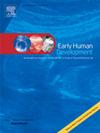Association between 2D:4D digit ratios and metabolic markers and hormonal parameters in children with premature adrenarche: A cross-sectional study from Türkiye
IF 2
3区 医学
Q2 OBSTETRICS & GYNECOLOGY
引用次数: 0
Abstract
Background
The appearance of pubic or axillary hair before the age of eight in girls or nine in boys, without other signs of puberty, is defined as premature adrenarche (PA) and may be an early sign of the metabolic syndrome. The second to fourth digit ratio (2D:4D), thought to reflect prenatal androgen exposure, has been associated with a variety of behavioral, metabolic, and hormonal conditions.
Objective
To evaluate the relationship between 2D:4D digit ratios and anthropometric, metabolic, and hormonal parameters in children with PA.
Methods
This cross-sectional study evaluated a Turkish sample of 49 children diagnosed with PA and 41 healthy controls, who were matched for age and gender. Anthropometric measurements, pubertal staging, biochemical and hormonal profiles, and bilateral 2D:4D ratios were recorded. Insulin resistance was assessed using the HOMA-IR, FGIR and QUICKI indices. Correlations between digit ratios and metabolic/hormonal markers were analyzed.
Results
Children with PA had significantly higher Body Mass Index (BMI), waist circumference, fasting glucose, insulin, HOMA-IR and DHEA-S levels, and lower QUICKI and FGIR values compared to controls (p < 0.05). No significant differences were found in 2D:4D ratios between groups. However, in the PA group, the left-hand 2D:4D ratio showed a negative correlation with DHEA-S and systolic blood pressure standard deviation scores (SDS) and a positive correlation with the waist-to-hip ratio (WHR), suggesting early hormonal and cardiovascular alterations in PA. In multivariable regression analysis, only DHEA-S found as an independent negative predictor of the left-hand 2D:4D ratio.
Conclusion
Although 2D:4D ratios may not distinguish between PA and controls, the left-hand 2D:4D ratio may serve as a subtle anthropometric marker reflecting hormonal and metabolic variations in children with PA. In multivariable regression, only DHEA-S remained an independent negative predictor of the left-hand 2D:4D ratio, highlighting the role of adrenal androgens in shaping digit ratio patterns in PA. Given the well-established link between PA and an increased risk of developing metabolic syndrome during adolescence, analysing digit ratios may provide additional value in the early assessment of metabolic risk.
来自 rkiye的横断面研究:2D:4D手指比率与早产儿肾上腺素代谢标志物和激素参数的关系
背景:女孩在8岁或男孩在9岁之前出现阴毛或腋毛,而没有其他青春期的迹象,被定义为肾上腺素过早(PA),可能是代谢综合征的早期征兆。第二和第四指的比例(2D:4D)被认为反映了产前的雄激素暴露,与各种行为、代谢和激素状况有关。目的探讨小儿PA的2D:4D指率与人体测量、代谢及激素参数的关系。方法本横断面研究评估了49名诊断为PA的土耳其儿童和41名年龄和性别匹配的健康对照。记录人体测量、青春期分期、生化和激素特征以及双侧2D:4D比值。采用HOMA-IR、FGIR和QUICKI指标评估胰岛素抵抗。分析手指比率与代谢/激素标志物之间的相关性。结果PA患儿体重指数(BMI)、腰围、空腹血糖、胰岛素、HOMA-IR和DHEA-S水平显著高于对照组,QUICKI和fghr值显著低于对照组(p < 0.05)。两组间2D:4D比值无显著差异。然而,在PA组中,左侧2D:4D比值与DHEA-S和收缩压标准偏差评分(SDS)呈负相关,与腰臀比(WHR)呈正相关,提示PA早期激素和心血管改变。在多变量回归分析中,只有DHEA-S被发现是左手2D:4D比的独立负预测因子。结论:虽然2D:4D比值不能区分PA和对照组,但左侧2D:4D比值可以作为反映PA患儿激素和代谢变化的微妙人体测量指标。在多变量回归中,只有DHEA-S仍然是左手2D:4D比例的独立负预测因子,突出了肾上腺雄激素在塑造PA手指比例模式中的作用。鉴于PA与青春期代谢综合征发病风险增加之间存在明确的联系,分析手指比例可能为早期评估代谢风险提供额外价值。
本文章由计算机程序翻译,如有差异,请以英文原文为准。
求助全文
约1分钟内获得全文
求助全文
来源期刊

Early human development
医学-妇产科学
CiteScore
4.40
自引率
4.00%
发文量
100
审稿时长
46 days
期刊介绍:
Established as an authoritative, highly cited voice on early human development, Early Human Development provides a unique opportunity for researchers and clinicians to bridge the communication gap between disciplines. Creating a forum for the productive exchange of ideas concerning early human growth and development, the journal publishes original research and clinical papers with particular emphasis on the continuum between fetal life and the perinatal period; aspects of postnatal growth influenced by early events; and the safeguarding of the quality of human survival.
The first comprehensive and interdisciplinary journal in this area of growing importance, Early Human Development offers pertinent contributions to the following subject areas:
Fetology; perinatology; pediatrics; growth and development; obstetrics; reproduction and fertility; epidemiology; behavioural sciences; nutrition and metabolism; teratology; neurology; brain biology; developmental psychology and screening.
 求助内容:
求助内容: 应助结果提醒方式:
应助结果提醒方式:


